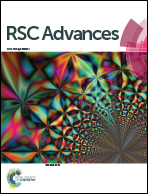Factors driving the self-assembly of water-soluble calix[4]arene and gemini guests: a combined solution, computational and solid-state study†
Abstract
Negatively charged gemini guests in the presence of a tetracationic host trigger the formation of self-assembling structures at physiological pH in water generating entities of the HG and H2G type (H = host and G = guest). ITC measurements show that the gemini guests are included via concerted electrostatic and hydrophobic interactions and that the formation of the HG adduct is enthalpically driven while the formation of the capsular entity (H2G) is driven by entropy gain. It is shown that the efficiency of capsule formation is influenced by the number of –CH2– units contained in the spacer and that spacers with an even number of methylene groups seem to be the best templating agents. In line with the above picture, MD simulations and DFT calculations show that the entropic contribution strongly depends on the length of the polymethylenic spacer. In the solid state, for the HG assembly three different structures are revealed by single crystal X-ray diffraction; the flexible interacting units create multiple interactions reaching the optimum balance between inter- and intramolecular energies. To the best of our knowledge, these are the first structures ever reported for water-soluble calixarenes and organic anions.
![Graphical abstract: Factors driving the self-assembly of water-soluble calix[4]arene and gemini guests: a combined solution, computational and solid-state study](/en/Image/Get?imageInfo.ImageType=GA&imageInfo.ImageIdentifier.ManuscriptID=C4RA09353D&imageInfo.ImageIdentifier.Year=2014)

 Please wait while we load your content...
Please wait while we load your content...